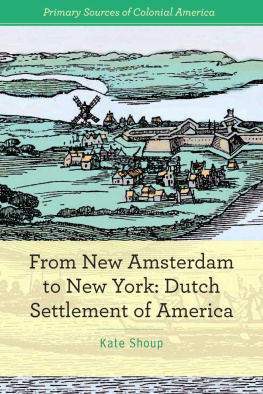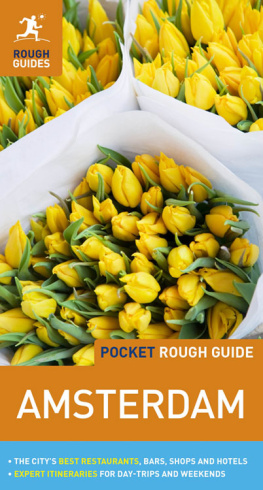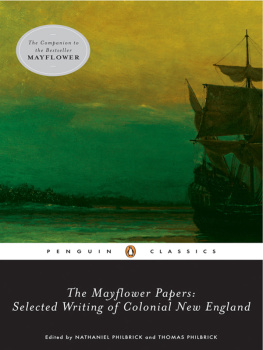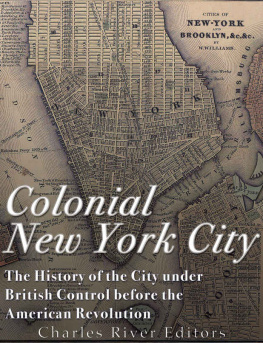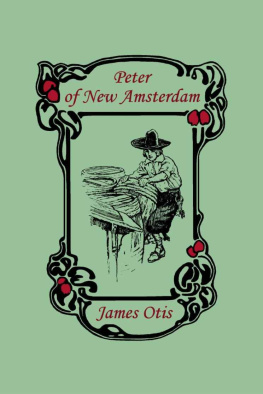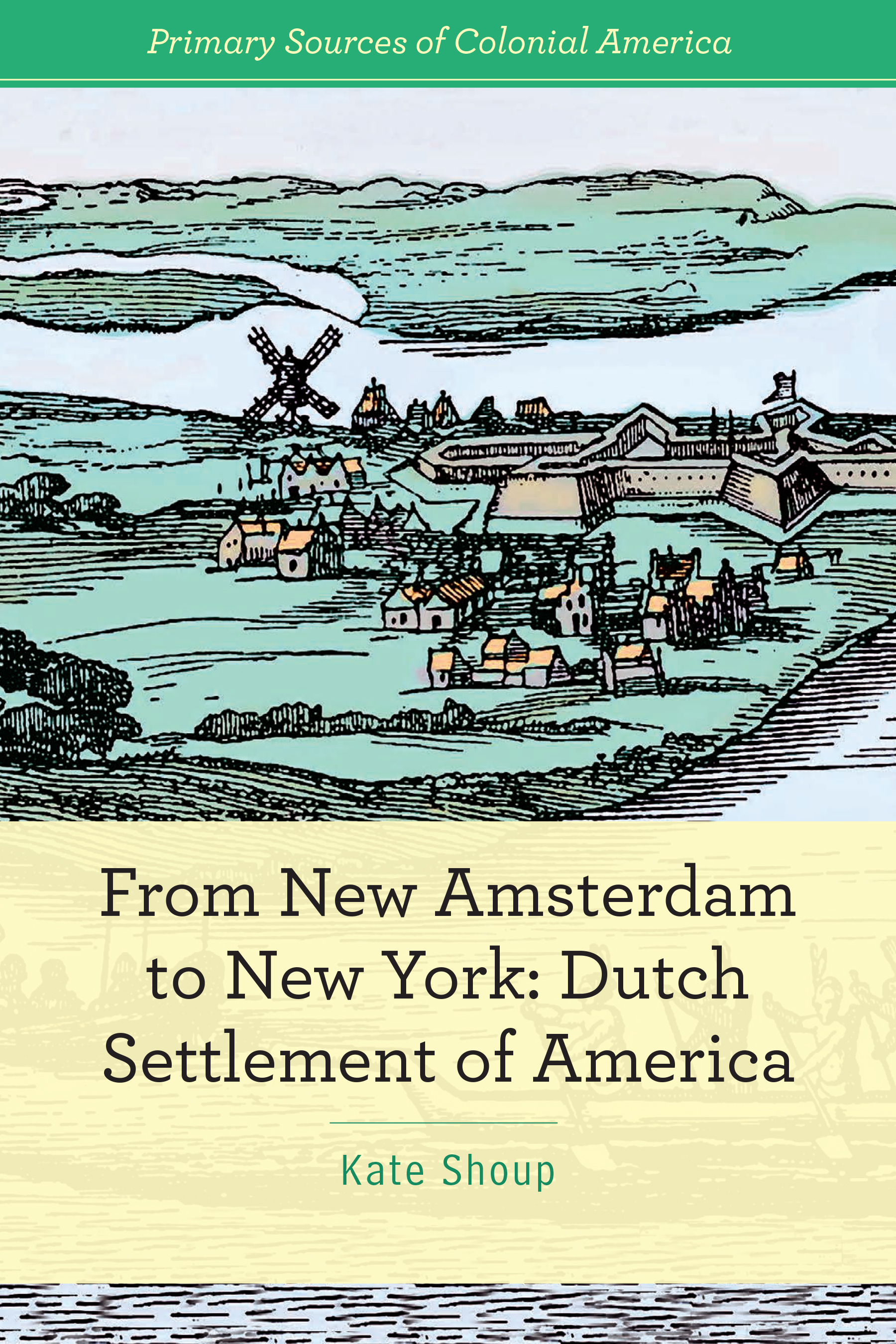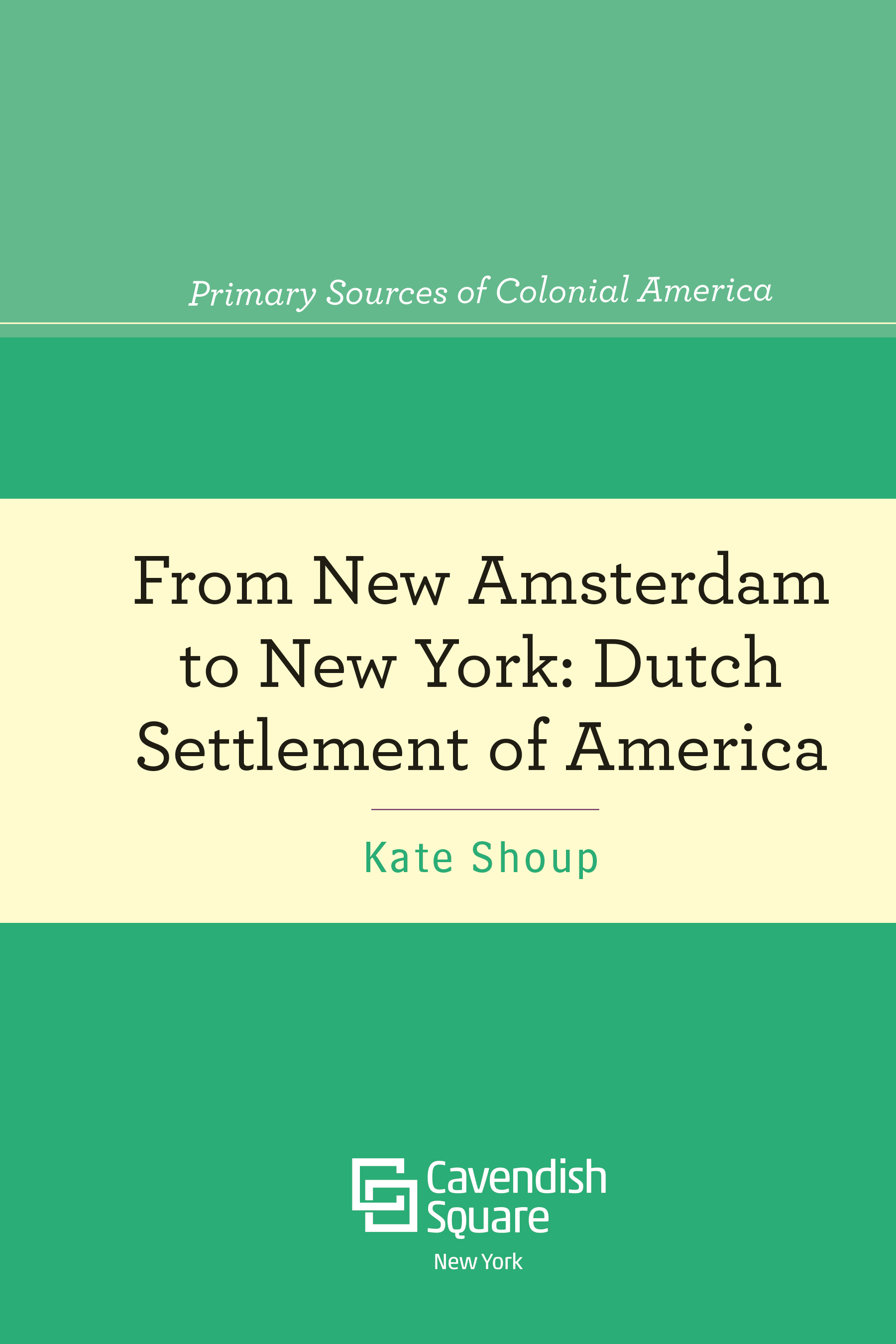- INTRODUCTION
Forgotten Influence - CHAPTER ONE
Settlement of a New World - CHAPTER TWO
The Dutch Presence Grows - CHAPTER THREE
Colonists Versus the Company - CHAPTER FOUR
The End of New Netherland
Published in 2018 by Cavendish Square Publishing, LLC
243 5th Avenue, Suite 136, New York, NY 10016
Copyright 2018 by Cavendish Square Publishing, LLC First Edition
No part of this publication may be reproduced, stored in a retrieval system, or transmitted in any form or by any means electronic, mechanical, photocopying, recording, or otherwisewithout the prior permission of the copyright owner. Request for permission should be addressed to Permissions, Cavendish Square Publishing, 243 5th Avenue,
Suite 136, New York, NY 10016. Tel (877) 980-4450; fax (877) 980-4454.
Website: cavendishsq.com
This publication represents the opinions and views of the author based on his or her personal experience, knowledge, and research. The information in this book serves as a general guide only. The author and publisher have used their best efforts in preparing this book and disclaim liability rising directly or indirectly from the use and application of this book.
All websites were available and accurate when this book was sent to press.
Library of Congress Cataloging-in-Publication Data Names: Shoup, Kate, 1972- author.
Title: From New Amsterdam to New York : Dutch settlement of America / Kate Shoup.
Other titles: Dutch settlement of America Description: New York : Cavendish Square Publishing, [2018] | Series: Primary sources of Colonial America | Includes bibliographical references and index.
Identifiers: LCCN 2017016270 (print) | LCCN 2017016715 (ebook) | ISBN 9781502631367 (library bound) | ISBN 9781502634580 (pbk.) | ISBN 9781502631374 (E-book)
Subjects: LCSH: Dutch--America--History--Juvenile literature. | Netherlands--Colonies--America--History--Juvenile literature. | New Netherland--History--Juvenile literature. | Frontier and pioneer life--New Netherland--Juvenile literature. |
Netherlands--Commerce--America--History--Juvenile literature. |
America--Commerce--Netherlands--History--Juvenile literature.
Classification: LCC E184.D9 (ebook) | LCC E184.D9 S48 2018 (print) | DDC 949.2/01--dc23
LC record available at https://lccn.loc.gov/2017016270
Editorial Director: David McNamara Editor: Fletcher Doyle Copy Editor: Rebecca Rohan Associate Art Director: Amy Greenan Designer: Lindsey Auten Production Coordinator: Karol Szymczuk Photo Research: J8 Media
The photographs in this book are used by permission and through the courtesy of: Cover INTERFOTO/History/Alamy Stock Photo; p. 5 Lee Snider Photo Images/Shutterstock.com; p. 6 North Wind Picture Archives/Alamy Stock Photo; p. 8 REMKO DE WAAL/AFP/Getty Images; p. 11 ullstein bild/ullstein bild via Getty Images; p. 12 Stock Montage/Getty Images; p. 15 Ann Ronan Pictures/Print Collector/Getty Images; p. 17 CORBIS/Corbis via Getty Images; p. 19 Culture Club/Getty Images; p. 21 Peter Minuit/Collection of the New-York Historical Society, USA/Bridgeman Images; p. 24 Nicolaes Visscher I/Wikimedia Commons/ File:Map-Novi Belgii Nov^que Anglic (Amsterdam, 1685).jpg; p. 27 North Wind Picture Archives/Alamy Stock Photo; p. 28 Interim Archives/Getty Images; p. 30 Esto/Getty Images; p. 34 Historical Picture Archive/CORBIS/Corbis via Getty Images; p. 38 Joseph Sohm/Shutterstock.com; p. 43 Attributed to Bartholomeus van Bassen/Wikimedia Commons/File:Great Assembly of the States-General in 1651 01.jpg; p. 45 Everett - Art/Shutterstock.com; p. 47 nam.ac.uk/Wikimedia Commons/File:James II (1685).jpg; p. 48 Jean Leon Gerome Ferris/Wikimedia Commons/File:The fall of New Amsterdam cph.3g12217.jpg; p. 50 New-York Historical Society Library, Maps Collection/Wikimedia Commons/File:Castelloplan.jpg; p. 51 Rainer Lesniewski/Shutterstock.com.
Printed in the United States of America

INTRODUCTION
Forgotten Influence
CHAPTER ONE
Settlement of a New World
CHAPTER TWO
The Dutch Presence Grows
CHAPTER THREE
Colonists Versus the Company
CHAPTER FOUR
The End of New Netherland
V irtually every student in the United States studies the colonization of America. Theyre taught that the first English settlers landed in Virginia in 1607. They learn that this first group was followed by the Pilgrims, who founded the Plymouth colony in 1620. Over the next 125 years, theyre told, more colonies formedthirteen in all. Finally, they learn that in 1776, the residents of these thirteen coloniesfed up with English rulelinked arms in revolt. The result was the formation of the United States of America.
So the story goes, anyway.
In fact, from 1609 until 1664, much of this land belonged to another group of Europeans: the Dutch. This Dutch colony, called New Netherland, encompassed four of the original thirteen British coloniesNew York, New Jersey, Delaware, and Connecticutand supported outposts in Pennsylvania and Rhode Island.
For many years, little was known about New Netherland.
It was believed that the Dutch kept meager recordsand that those they did keep did not survive. Thats changing, however. Recently, historians discovered troves of documents that reveal the workings of this colonyits society, its culture, its practices, and perhaps most importantly, its people. These documents also reveal just how much of an impact New Netherland had on Americaan impact that, until now, has gone largely unappreciated.

The Old Dutch Church of Sleepy Hollow dates to 1685. It is a reminder of the influence of the Dutch in the region and of New York's history of religious liberty.
New Netherland, we now know, was a remarkably free societya hallmark of modern American culture. This free society reflected the greater Dutch culture during this perioddescribed by one historian as the most progressive and culturally diverse society in Europe. Also, the Dutch believed in religious tolerance. The US Constitution guarantees that Congress shall make no law respecting an establishment of religion, or prohibiting the free exercise thereof. Likewise, the Union of Utrecht, the Dutch nations founding document, stated that everyone shall remain free in religion and that no one may be persecuted or investigated because of religion. Unlike other European countries, which often closed their doors to outsiders, the Dutch accepted everyoneProtestant, Catholic, Jew, Muslim, and otherwise. The result was a vibrant population and society.

The Dutch were the first Europeans to settle the area we now call New York. Here, Peter Stuyvesant lectures people on morality.
While the English Pilgrims and Puritans colonized New England so they could practice their religion as they saw fit, the Dutch had another aim: to exploit the areas rich natural resources for profit. To achieve this, the countrys powerful merchant class dangled the prospect of upward mobility to anyone willing to make the trip to the New World. People of all kinds accepted the challenge. The result was a very different kind of colony from those in New England. It was closer to the colony in Virginia, but it opened opportunity for more people than in Jamestown. Instead of the prim, theocratic monoculture of the Pilgrim and Puritan colonies of New England, notes journalist Andrea Stone, New Netherland was a cacophony of religions, races, and ethnic groups as well as people involved in illegal activities such as smuggling and piracy.

